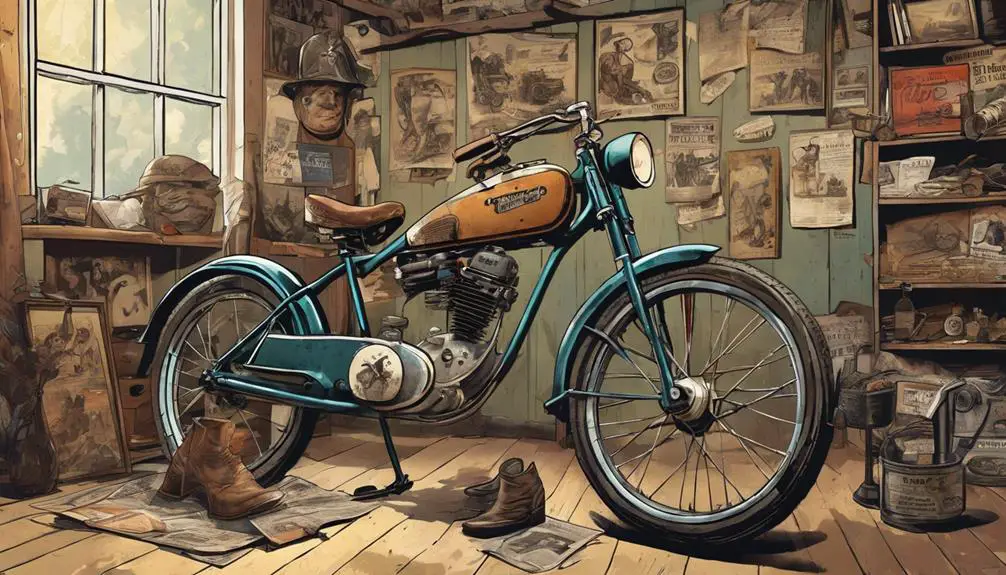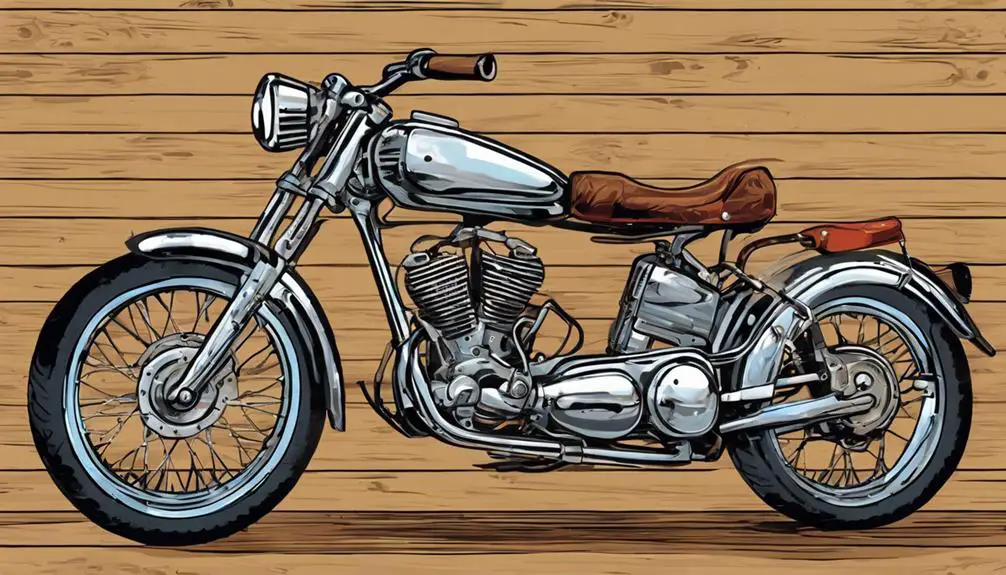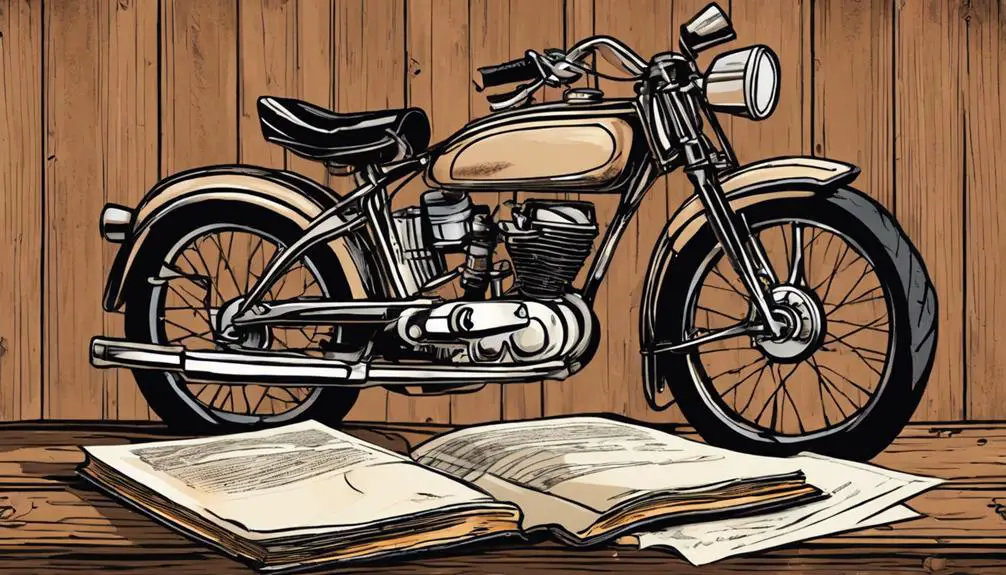Like a classic car at a vintage auto show, the resale value of a vintage bike hinges on several nuanced factors you might not have considered. You'll find that elements such as historical significance, condition, and even the originality of parts can make a substantial difference in what buyers are willing to pay. But it doesn't stop there; rarity and demand also play pivotal roles in this intricate marketplace. As you explore these aspects, you may uncover surprising insights that could influence your next transaction.
Quick Takeaways
- Historical significance enhances demand, as vintage bikes symbolize cycling culture and craftsmanship from their production era.
- The overall physical condition and maintenance history of the bike greatly impact its resale value.
- Original parts in good condition increase value, while modifications must appeal to potential buyers.
- Rarity and demand are crucial, with limited production numbers and collector interest driving up prices.
Historical Significance

The historical significance of vintage bikes lies in their ability to connect you to a rich tapestry of cycling culture and innovation. Each bike tells a story, reflecting the era in which it was produced, the technological advancements at the time, and the passion of those who rode them. As you pedal through the streets on a vintage model, you're not just riding; you're participating in a legacy that champions freedom and exploration.
These bikes symbolize a movement that transcends mere transportation. They represent a rebellion against mass consumerism and a return to craftsmanship, emphasizing individuality and sustainability. You feel the spirit of past cyclists who embraced the wind in their hair and the open road ahead, seeking adventure and liberation.
Owning a vintage bike means you're part of a community that values history and authenticity. You connect with fellow enthusiasts who share your passion for the bygone era of cycling. This bond enhances your experience, reminding you that every ride is a tribute to those who dared to dream beyond the confines of their time.
Embrace this journey, and let the wheels of history roll beneath you, guiding you to your own sense of freedom.
Condition and Maintenance
When evaluating a vintage bike's resale value, its overall physical condition plays an essential role.
You'll want to take into account maintenance history records as they can greatly impact buyer perception.
Keeping your bike in top shape not only preserves its value but also attracts more interested buyers.
Overall Physical Condition
How well a vintage bike's been maintained greatly impacts its resale value. When you're looking to sell, the overall physical condition is vital. A bike that shines with fresh paint and polished chrome signals care and passion, drawing potential buyers in. If the frame shows rust or the tires are worn, it raises red flags, suggesting neglect.
You want to focus on details that matter. Check for scratches and dents; they tell a story of its journey. A clean, well-maintained bike not only looks appealing but also indicates you've invested time and effort into its upkeep. This effort can translate into a higher price tag when you decide to part ways with it.
Don't underestimate the importance of components like brakes, gears, and chains. If they're functioning smoothly, they enhance the bike's allure. Even the seat should be in good shape, as comfort matters to riders.
Maintenance History Records
Keeping detailed maintenance history records can greatly boost a vintage bike's resale value. When you document every service, repair, and upgrade, potential buyers see that you've cared for your bike. This not only builds trust but also shows you've invested in its longevity.
Imagine a buyer looking at two similar bikes; one comes with a stack of receipts and a clear record of maintenance, while the other lacks documentation. Which one do you think they'll choose? Having a well-kept history can make your bike feel like a treasured artifact, worth every penny.
Regular maintenance guarantees your vintage bike stays in top condition, and recording every detail proves your commitment to excellence. Include dates, mileage, and descriptions of work done, along with any parts replaced. This transparency can empower buyers, giving them the confidence to invest in your bike.
Ultimately, when you take the time to maintain and document your bike's history, you're not just preserving its value; you're liberating its potential. Your attention to detail can set your bike apart in a competitive market, transforming it into a coveted piece of history.
Original Parts and Modifications

Original parts considerably enhance a vintage bike's resale value, while modifications can either boost or diminish it depending on their quality and relevance.
If you're looking to sell, keeping original features intact can draw in buyers who appreciate authenticity. However, if you've made upgrades, it's essential to reflect on how they resonate with potential buyers.
Here are some factors to ponder when it comes to original parts and modifications:
- Condition: Original parts must be in good shape; wear and tear can lower value.
- Relevance: Modifications that improve performance, like better brakes or tires, can be appealing.
- Aesthetics: Cosmetic changes, like paint jobs, may enhance or hurt a bike's classic appeal.
In the end, it's about finding that balance. You want your bike to reflect your personality while still appealing to the broader vintage bike community.
Aim for a blend of personal expression and preservation, and you'll maximize that resale value!
Rarity and Demand
When it comes to vintage bikes, rarity and demand play an essential role in determining value.
Limited production numbers can greatly boost a bike's appeal, especially among collectors who appreciate historical significance.
Understanding these factors helps you make informed decisions when buying or selling your vintage ride.
Production Numbers Impact Value
Production numbers play a crucial role in determining a vintage bike's rarity and demand, directly influencing its resale value. When fewer bikes are produced, the ones that remain become treasures sought after by enthusiasts. If you're looking to maximize your investment, understanding production numbers is key.
Here are some factors related to production numbers that can impact value:
- Limited Editions: Bikes made in small batches often command higher prices.
- Discontinued Models: When a model is no longer in production, its value can rise as collectors seek it out.
- Unique Features: Models with specific features or variations can become highly desirable.
Popularity Among Collectors
Many collectors are drawn to vintage bikes due to their rarity and the stories they carry, making them highly sought after in the resale market.
When you look for a vintage bike, remember that its value often hinges on how many of that model exist and how much demand there's among enthusiasts. If a bike is rare, it's likely to spark interest, and that excitement can drive up its price.
Think about how passionate you feel when you find a unique piece that resonates with your spirit. That desire isn't just personal; it's a collective vibe among collectors.
The more people want a specific model, the higher its resale value climbs.
Historical Significance and Appeal
Vintage bikes often hold significant historical value, which can greatly enhance their appeal and demand among collectors. When you find a bike steeped in history, you're not just buying a mode of transport; you're acquiring a piece of the past. The rarity of certain models or brands can make them highly sought after, driving up their value.
Here are a few factors that contribute to a bike's historical significance:
- Limited Production Runs: Bikes produced in small quantities often become rare treasures.
- Iconic Designs: Unique or groundbreaking designs catch the eye of enthusiasts.
- Cultural Impact: Bikes that played a role in significant events or movements resonate with collectors.
As you navigate the world of vintage bikes, remember that rarity and demand are intertwined. The more unique the bike, the more likely it'll attract passionate collectors.
Embrace the liberation that comes with owning a piece of history, and watch your investment grow in both value and appreciation.
Documentation and Provenance

Having solid documentation and a clear provenance can markedly enhance your vintage bike's resale value. When you can showcase the bike's history, you're not just selling a machine; you're offering a piece of history that others can connect with. Collecting original paperwork—like purchase receipts, service records, and manuals—provides a tangible narrative that potential buyers appreciate.
Provenance isn't just about documents; it's about the story behind the bike. If you know previous owners or can trace its journey, share that story. This connection adds emotional value, making your bike more than just a commodity. Buyers often feel liberated when they can see the lineage of their potential purchase, knowing they're acquiring something authentic.
Keep everything organized—perhaps in a binder or a digital format—and make it easy to present. When you're ready to sell, potential buyers will feel reassured by the transparency and care you've invested in maintaining your bike.
Ultimately, solid documentation and provenance not only elevate your bike's value but also enrich the experience for both you and the buyer, fostering a deeper appreciation for the vintage cycling world.
Market Trends and Pricing
Understanding current market trends and pricing is essential for maximizing the resale value of your vintage bike. You need to stay informed about what's hot and what's not in the cycling community. Demand can shift rapidly, and being aware of these changes can empower you to sell at the right time for the best price.
Consider these key factors that influence market trends and pricing:
- Rarity: Limited production models or unique features can drive up interest.
- Condition: A well-preserved bike will always fetch a premium compared to one in disrepair.
- Brand Reputation: Some brands carry more prestige, enhancing perceived value.
Common Questions
How Do Weather Conditions Affect Vintage Bike Resale Value?
Weather conditions can greatly impact a vintage bike's resale value.
If you've kept your bike in a damp garage, rust might set in, degrading its condition and worth. Harsh sunlight can fade paint and damage components, too.
Conversely, if you've protected your bike from the elements, it'll likely fetch a higher price.
Can Color or Finish Impact a Bike's Resale Price?
Absolutely, color and finish can greatly impact a bike's resale price.
If you've got a vibrant, eye-catching paint job, it's likely to attract more buyers. A unique or factory-original finish often commands a premium.
On the flip side, dull or faded colors might turn potential buyers away.
What Role Do Social Media and Online Communities Play in Value?
In a world where passion meets connection, social media's power can elevate your bike's value.
You're not just selling a vintage ride; you're sharing a story. Online communities thrive on shared enthusiasm, creating buzz that can drive demand.
When you showcase your bike on platforms, it resonates with fellow enthusiasts, igniting interest. This engagement amplifies your bike's allure, turning it into more than just a vehicle—it's a symbol of freedom and shared adventure.
Do Previous Ownership Histories Influence Resale Value Significantly?
Absolutely, previous ownership histories can greatly influence resale value.
When you see a bike once owned by a famous rider or featured in a notable event, its value skyrockets. Buyers often feel a connection to the bike's story, making it more desirable.
If you know the bike's past, you can leverage that information to negotiate a better price.
How Does the Economy Impact Vintage Bike Resale Markets?
Economic ebbs and flows fuel the vintage bike resale scene.
When the economy thrives, buyers flock to unique machines, driving prices up.
Conversely, during downturns, demand dwindles, and you might see values plummet.
If you're looking to sell, keeping an eye on economic trends can help you time your sale perfectly.
Remember, a strong economy sparks interest, while a struggling one stifles sales.
Stay savvy, and embrace the shifts!
Wrapping Up
When selling a vintage bike, remember that its value goes beyond just the bike itself; it's about the story it tells.
You might think the market's too unpredictable, but understanding these key factors can help you navigate it effectively.
By focusing on historical significance, condition, and documentation, you can enhance your bike's appeal.
With the right approach, you can attract passionate buyers willing to pay a premium for your cherished ride.